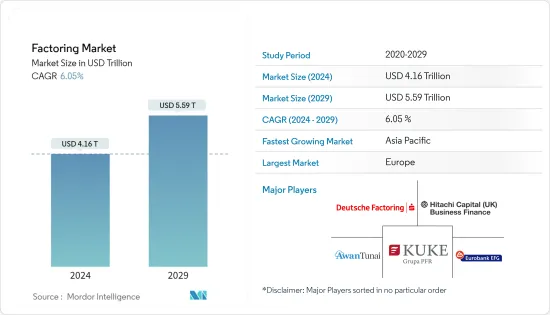PUBLISHER: Mordor Intelligence | PRODUCT CODE: 1521544

PUBLISHER: Mordor Intelligence | PRODUCT CODE: 1521544
Factoring - Market Share Analysis, Industry Trends & Statistics, Growth Forecasts (2024 - 2029)
The Factoring Market size is estimated at USD 4.16 trillion in 2024, and is expected to reach USD 5.59 trillion by 2029, growing at a CAGR of 6.05% during the forecast period (2024-2029).

The market's expansion can be primarily ascribed to the increase of open account trading and international commerce. The industry is expanding because of the need for alternate financing sources for SMEs and startups. It is anticipated that technological advancements such as distributed ledgers and blockchain would enhance the supply chain process by lowering operating costs and bolstering system security.
There are various influences propelling the market forward, including a rising need for alternative financial solutions, expanding global trade, notable technological progress, increasing economic unpredictability, the ongoing practice of outsourcing non-essential functions, and heightened competition among factoring companies.
Technology is revolutionizing the factoring sector. Therefore, factoring is now simpler and more effective because of the usage of cutting-edge technology like blockchain, artificial intelligence, and data analytics. Artificial intelligence (AI) is being utilized more and more to evaluate credit risk in real-time. This helps to expedite the approval process by producing evaluations that are quicker and more accurate.
Factoring assists companies in obtaining working capital loans and reducing credit risk. It also offers factoring, a benefit of supply chain financing. The expansion of the banking, finance, and insurance industries is one of the factors propelling the market's growth. The market is expanding due to the rising need for MSME financing, another source of funding.
In affluent nations, importers are also thinking about factoring as a substitute for conventional trade financing. Increased knowledge of international trade and the transfer of industrial operations from China to developing nations like Vietnam, Mexico, and the Philippines following COVID-19 have both contributed to the growth of the international segment.
Factoring Market Trends
Banks have the Largest Market Share in the Factoring Market
Banks, the largest financing organizations in the world, are expected to experience significant growth during the forecast period. This is one of the major factors driving growth in this segment. Banks are investing in cutting-edge technologies such as DLT (Distributed Ledger Technology) and Blockchain to address their clients' financial needs. Direct access to cash, the assurance of a regulated bank, and more competitive rates are some of the factors driving growth in the segment.
Many factoring services providers, such as Eurobank (Eurobank Fiduciaire SA), REV Capital, Trade Wind Finance, etc., are adopting different business models to diversify their services portfolio to attract new business customers. For example, in the previous year, Eurobank Factors (a subsidiary of Eurobank), a factoring services provider, announced new enhancements to its factoring business and the launch of new digital factoring services. The new digital factoring services offered by the bank are designed to assist clients in improving their cash flow ratio and to offer loyalty schemes on concessional terms.
Europe is Expected to Dominate the Market
Europe is the biggest contributor to the industry. The top five players in terms of factoring volume are France, the United Kingdom, Germany, Italy, and Spain. Several markets outperformed expectations, with impressive growth rates, such as Poland, Romania, and Russia, as well as Bulgaria and the Czech Republic.
While there is a general increase in factoring adoption across Europe, Eastern Europe is experiencing the highest growth rate. As the financial and business market in the CEE region continues to harmonize and align with Western European banking standards (partly driven by the market penetration of the region's banking groups), there are improved and more effective standards and stricter regulations to prevent the risk of corrupt practices.
Factoring Industry Overview
Additional Benefits:
TABLE OF CONTENTS
1 INTRODUCTION
- 1.1 Study Assumptions and Market Definition
- 1.2 Scope of the Study
2 RESEARCH METHODOLOGY
3 EXECUTIVE SUMMARY
4 MARKET DYNAMICS
- 4.1 Market Overview
- 4.2 Market Drivers
- 4.2.1 Rising Adoption of Fintech Among SMEs is Driving Market Growth
- 4.2.2 Rising International Trade and Digitalization are Driving Market Growth
5 MARKET SEGMENTATION
6 COMPETITIVE LANDSCAPE
7 MARKET OPPORTUNITIES AND FUTURE TRENDS




